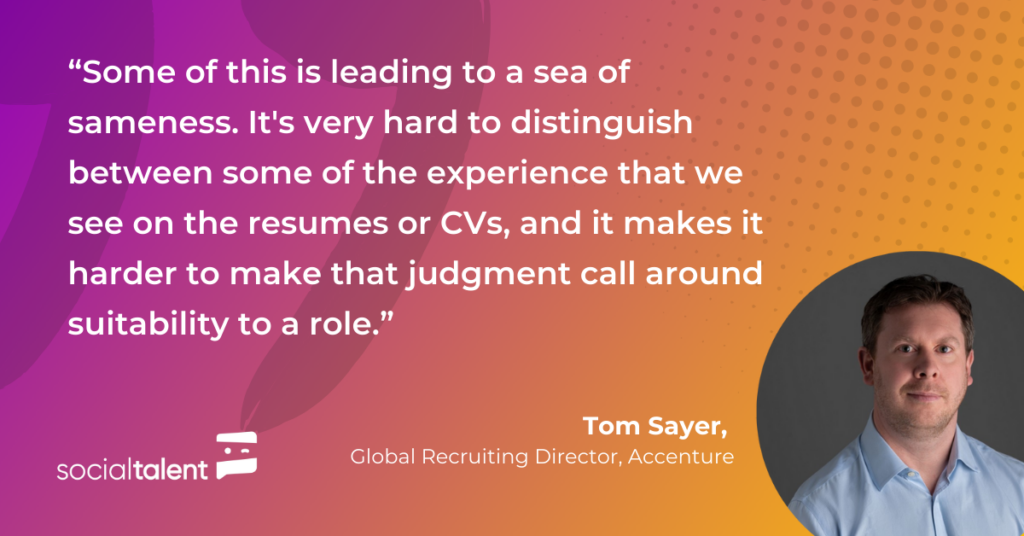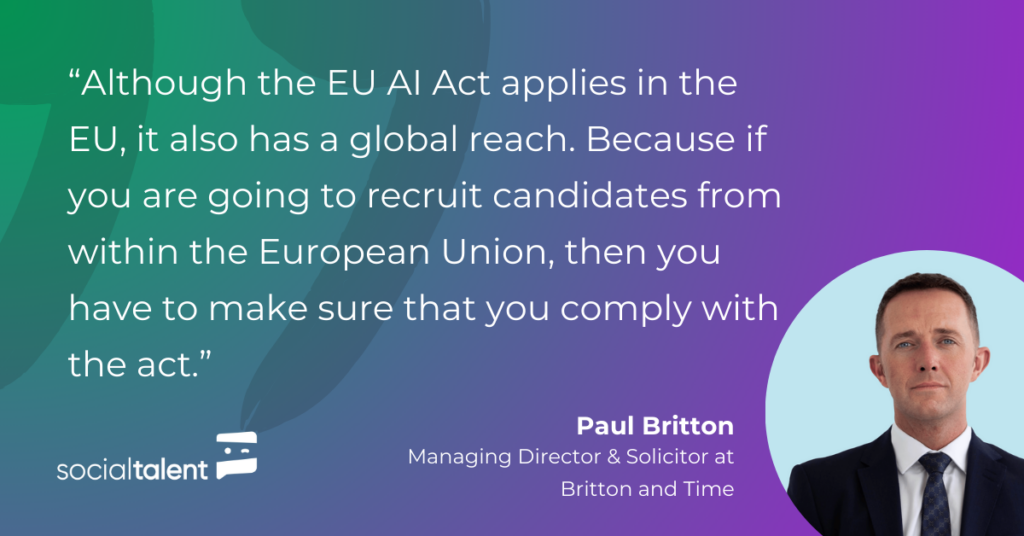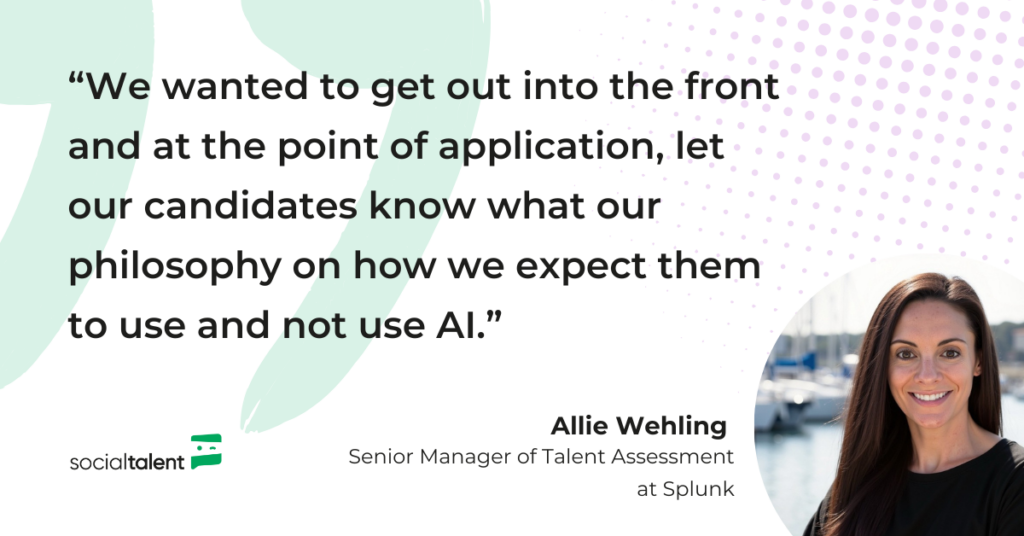Tackling AI-Driven Candidate Cheating: Insights from SocialTalent Live
AI is transforming the hiring process – but not always in ways organizations expect. As artificial intelligence becomes more accessible, candidates are leveraging it to mass-apply for roles, generate polished resumes, and even complete assessments. This growing trend raises critical questions for hiring teams: How can recruiters ensure candidate authenticity? What are the legal and ethical boundaries of AI use in hiring?
These were the central themes of SocialTalent Live: Tackling AI-Driven Candidate Cheating, our latest virtual event, where industry experts came together to explore the impact of AI on candidate integrity and share strategies for maintaining fairness in recruitment.
Hosted by our very own Johnny Campbell, CEO of SocialTalent, the event featured three insightful discussions with top talent leaders:
- Tom Sayer, Associate Director, Global Recruiting, Accenture
- Allie Wehling, Senior Manager, Talent Assessment, Splunk
- Paul Britton, Managing Director & Solicitor, Britton and Time
Below, we’ll dive into the key insights and actionable takeaways from each session, providing a roadmap for organizations looking to navigate the evolving landscape of AI in hiring.
1. Understanding the Challenge of AI
Key theme: The prevalence of AI-assisted candidate misrepresentation, discussing the scale of the problem, how to identify it, its impact on the recruitment process, and how to address it.
AI’s impact on hiring has been a hot topic, but few organizations have seen its effects at scale like Accenture. With 150,000 hires annually and a 30% surge in applications, Tom Sayer, Accenture’s Associate Director of Global Recruiting, shared eye-opening insights. But the question isn’t just whether AI is being used – it’s how it’s reshaping the hiring landscape.
The Scale of the Problem
Accenture’s recent recruiter survey found that 29% of recruiters frequently encounter AI-enhanced CVs – a figure echoed in broader industry research. Reports suggest that up to 50% of applications now involve AI-generated content, with ChatGPT making an average of 14 embellishments per CV. These enhancements don’t just pad resumes; they inflate skills, obscure experience gaps, and create a “sea of sameness” that makes it harder for recruiters to identify standout candidates.
More applications should be a good thing, right? Not when they overwhelm hiring systems and negate hard-won efficiencies in screening and selection. “If you’ve got a leaky bucket at the top of the funnel, all those efficiencies get lost further down,” Tom noted. The increase in applications isn’t just a numbers game – it has real consequences for recruiter workload and business decision-making.

The AI Interview Dilemma
It’s not just CVs that are seeing AI’s influence – AI-assisted interviews are becoming a growing concern. Recruiters at Accenture have flagged 10% of digital interviews as potentially AI-assisted. The telltale signs? Long pauses before responses, robotic phrasing, and candidates seemingly reading from a screen.
The issue isn’t just about deception – it’s about assessing real capability. While AI-enhanced resumes may help candidates showcase their skills more effectively, they can also create misalignment between perceived and actual abilities. Recruiters are finding that when candidates move past automated screening to live interviews or skills assessments, the cracks begin to show.
The Role of Proctoring and Digital Assessments
One of Accenture’s solutions has been to push digital assessments earlier in the hiring process – but with a crucial change: proctoring. Tom shared that when proctoring was introduced, pass rates dropped significantly, despite recruiters sending through candidates with seemingly strong CVs. “This suggests a gap between what candidates tell us they can do and what they can actually perform in real-world assessments,” he explained.
The goal is to move away from resume-based filtering and toward skills-based hiring, where actual capabilities matter more than polished applications.
The challenge isn’t just stopping AI misuse, however, it’s defining acceptable AI use. Should candidates be penalized for using AI to refine their CVs? Or should hiring teams assess AI literacy as a critical skill? Tom emphasized that clear policies, recruiter training, and candidate guidance are crucial next steps. AI isn’t going away, and organizations need to decide: How do we hire in a world where AI is a co-pilot, not a crutch?
2. Legal Perspectives of AI and Recruiting
Key theme: The implications of the AI Act on hiring practices, clarifying what organizations are permitted to do, and how to navigate the legal landscape concerning AI in recruitment.
AI’s role in recruitment isn’t just a matter of efficiency – it’s now a legal minefield. Paul Britton, Managing Director & Solicitor at Britton and Time, joined us to unpack the EU AI Act and its impact on hiring. With steep penalties of up to €27 million, organizations need to start paying attention.
Understanding the EU AI Act in Hiring
The EU AI Act, which officially came into force on August 1, 2024, categorizes AI use in hiring as “high-risk.” While enforcement won’t begin until 2026, companies worldwide will be affected – not just those based in the EU. Any organization that recruits candidates from the EU must comply, making it a global issue rather than a regional one.
Paul outlined five key principles that hiring organizations must follow when using AI:
- Transparency – Candidates must be explicitly informed when AI is used in their hiring process.
- Explainability – Organizations must be able to clearly articulate how AI-driven decisions are made.
- Traceability – AI systems must provide an audit trail showing their decision-making logic.
- Human Oversight – AI cannot fully automate hiring decisions; a human must always be involved in the final selection.
- Candidate Consent – Applicants must actively opt-in to AI-driven processes, ideally through multiple consent steps to ensure compliance.

Common Misconceptions About AI Hiring Compliance
One of the biggest misconceptions is that only employers are responsible for AI compliance. Paul made it clear: both the employer and the technology vendor share responsibility. If a third-party AI system is being used to screen candidates, it’s not enough for a company to assume the vendor has everything covered. Employers need to proactively engage with vendors and ensure their tools comply with legal standards.
Many organizations risk non-compliance simply by not understanding how AI is being used in their hiring tech stack. If a vendor upgrades its recruitment software to include AI-based decision-making, employers must confirm that it aligns with legal requirements – especially around explainability and human oversight.
Skeptics might argue that regulations like these often lack enforcement. But history suggests otherwise. Johnny pointed out the early days of GDPR, when many dismissed it as toothless – only for major corporations to face fines in the hundreds of millions a few years later. The same could happen with AI compliance, as regulators build momentum.
What Happens When Candidates Misuse AI?
A growing concern is not just AI-enhanced resumes, but AI-assisted interviews – as we mentioned in Tom’s section. Many organizations are now spotting candidates using AI tools during live interviews.
So what should recruiters do if they detect AI involvement during an interview?
Paul recommended setting clear candidate guidelines upfront, such as:
- Requiring candidates to certify that they won’t use AI during the interview.
- Automatically disqualifying candidates if AI use is detected and they refuse to turn it off.
- Providing a warning first, giving candidates a chance to correct their behavior before being removed from the process.
With historical data showing that over 70% of candidates have lied on resumes, AI-powered deception is simply a newer, more sophisticated version of an old problem. Employers must decide their stance – and communicate it clearly.
3. Embracing AI in Recruitment
Key theme: The importance of a transparent AI philosophy, focusing on enhancing candidate capabilities, addressing risks of misrepresentation, and leveraging AI to empower recruiters and maintain a competitive edge.
The conversation around AI in hiring has been dominated by concerns about fraud, legal compliance, and recruiter challenges. But what if AI wasn’t just something to police, but something to harness? That’s the approach Splunk has taken, and Allie Wehling, Senior Manager of Talent Assessment at Splunk, shared how her team built an AI hiring philosophy that promotes transparency, fairness, and trust.
Taking a Proactive, Not Reactive, Approach to AI
Many organizations facing AI’s impact on hiring take one of two approaches:
- Ignore it – Keep their heads down and hope for the best.
- Ban it outright – Prohibit AI use entirely.
Splunk chose a third option: Embrace AI while setting clear expectations. Instead of waiting for issues to emerge, they got ahead of the problem by creating a clear AI hiring philosophy. This isn’t buried in a legal document – it’s front and center on their career site, in candidate communications, and even reinforced across LinkedIn and social media. The foundation of this strategy? Transparency.

Guiding Candidates on the Right Way to Use AI
One of the most controversial debates in hiring today is whether AI-assisted candidates should be disqualified. But Allie made a great point in her talk: AI can be a great equalizer, particularly for marginalized job seekers, internal hires, and those with limited career coaching resources.
Rather than outlawing AI, Splunk educates candidates on how to use it effectively, without crossing ethical lines. For example:
Good AI Use Cases
- Resume proofreading – AI can assist with grammar and clarity.
- Interview prep – Just like a human career coach, AI can help candidates anticipate potential questions and structure responses.
Unacceptable AI Use Cases
- Misrepresenting experience – Fabricating credentials is a deal-breaker.
- Live interview assistance – Reading from AI-generated content is not a true representation of skills.
- Copy-pasting full code solutions – Using AI to generate entire responses in technical interviews is not acceptable.
Training Recruiters to Detect Skill, Not AI
Recruiters and hiring managers often feel ill-equipped to navigate AI in hiring. But Allie wants to empower recruiters to focus on validating skills – not on detecting AI use.
“We’re not trying to make interviewers AI detectives,” Allie explained. “We’re training them to be great assessors of skill.” Splunk provides structured training to ensure interviewers can probe deeper when responses feel generic or overly polished and align interview questions with actual job expectations. The ultimate goal isn’t to catch candidates using AI – it’s to ensure they can actually do the job.
Conclusion
AI is transforming hiring, bringing both opportunities and challenges. SocialTalent Live highlighted the urgency of balancing innovation with integrity, as organizations tackle AI-driven candidate cheating, compliance, and fair hiring practices. The key takeaway? Transparency, clear policies, and skill-based assessments are essential. By embracing AI responsibly—not fearing or banning it outright—companies can create a fairer, more efficient hiring process while ensuring candidates are assessed on real ability, not just AI-enhanced resumes.
